Different Types of Dental Bridges
There are several types of dental bridges available so dentists can meet the unique needs of their patients. These different kinds of bridges include:

Dental bridges in Succasunna are designed to restore between one or more missing teeth in a row, helping you regain your confidence as well as the function of your smile. As an experienced restorative dentistry expert, Dr. Goldberg can help provide patients in need with beautiful, customized replacement teeth that they’ll feel proud to show off.
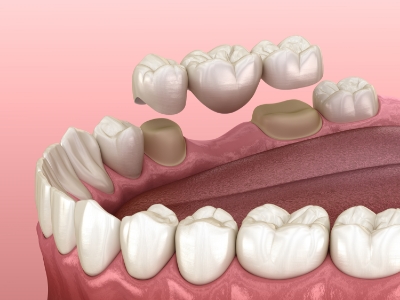
A dental bridge is a restoration that can replace one tooth or several consecutive teeth. This prosthesis bridges the gap between the adjacent teeth or dental implants. A bridge is made up of artificial teeth and dental crowns. The dental crowns are typically located on both sides of the artificial teeth, also called pontics. The crowns are the portion of the bridge that will anchor the entire unit to the adjacent teeth, also called the abutment teeth, or to the dental implants.
There are several types of dental bridges available so dentists can meet the unique needs of their patients. These different kinds of bridges include:
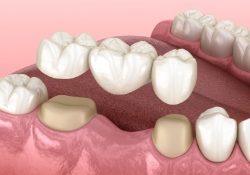
This is similar to the bridge just described. The crown portion of the bridge is cemented to the adjacent teeth to secure the prosthesis. The adjacent teeth are significantly reduced in size to create room for the crowns. The disadvantage of a traditional bridge is it places a lot of extra stress on these teeth and they are permanently altered. The extra stress on these teeth can lead to further damage or cavity formation. You are also basically damaging two healthy teeth to replace a few missing teeth.
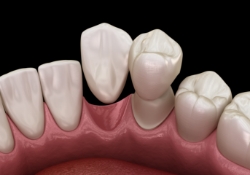
A cantilever dental bridge is just like a traditional bridge with one slight difference. The bridge will only attach to one adjacent tooth instead of two. This is not the first choice of dental bridges since they are less stable. If a dentist must use it, a common location is teeth towards the front of the mouth where less chewing force is needed. The disadvantage of a cantilever bridge is it places a lot of extra stress on the one anchor tooth. For this reason, you will not often see one used to replace teeth in the back of the mouth. However, if placed correctly, it can save a patient time and money.
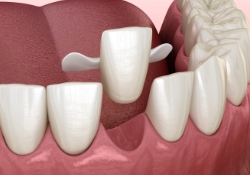
A Maryland bridge is unlike other dental bridges. It can only replace a single tooth. The pontic is situated on a framework made of metal or porcelain. The framework is fixed to the back of the adjacent teeth. The advantage to using this type of bridge is the adjacent teeth do not need to be modified to accommodate the framework. It is also more affordable than a traditional dental bridge. A Maryland bridge will use a strong dental adhesive to secure the framework to the back of the adjacent teeth.
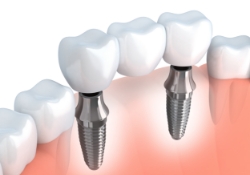
The best way to secure a dental bridge is with dental implants. If you have several consecutive missing teeth, our dental team can create a plan to insert at least two dental implants into your jawbone. Then we will custom make a bridge that will attach to those implant fixtures. The benefit of using teeth implants is there is no need to use any healthy teeth to secure the bridge. Also, the implants will help provide enough stimulation for the jawbone to prevent bone loss in the jaw.
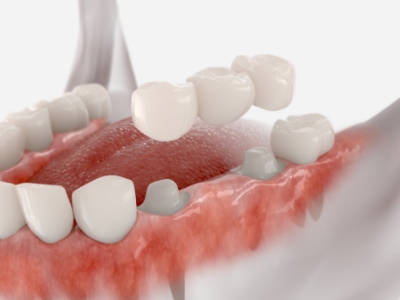
Prior to treatment, Dr. Goldberg will assess your oral health to determine if you have enough healthy bone and gum tissue needed for this procedure. He will also take your goals and budget into account.
Dental bridges are a restorative option that can be anchored by natural adjacent teeth or dental implants. When using existing teeth it is often necessary to place dental crowns for the most stable result. When used in conjunction with dental implants, dental bridges can be permanent, long-lasting replacements for missing teeth. Dr. Goldberg’s dental expertise is rooted in restorative treatments using dental implants. He will ensure that the placement of implants is conducive to your needs.
A removable dental bridge should be taken off and cleaned twice a day. Implant-secured dental bridges can be maintained like regular natural teeth.
No, it is not painful because teeth are numbed with anesthesia during the procedure.
The dental bridge procedure usually takes an hour to an hour-and-a-half over two office visits. For implant bridges, implants are prepared for crowns in the first visit and the dental bridge is added during the second part of the procedure.
On average, it takes about two weeks for patients to adjust to a new dental bridge. While adjusting, patients may stick to a soft diet and avoid hot or cold foods to prevent sensitivity.
After a dental bridge is placed patients should wait at least one hour before eating. This gives cement time to harden and cure. Patients should avoid hard or sticky foods for the first few days while adjusting to the feeling of their new bridge.
Patients can clean under their dental bridge by using floss to wrap between and around the implanted bridge. Scheduling professional cleanings is also a good way to clean under your bridge. Dentists have special tools that can clean beneath your bridge, removing any bacteria or plaque.
Patients with a bridge can eat normally after they have adjusted to the implant. During the first few weeks, while adjusting, patients may stick to a soft diet. Once the bridge begins to feel normal patients may begin going back to their regular eating habits.